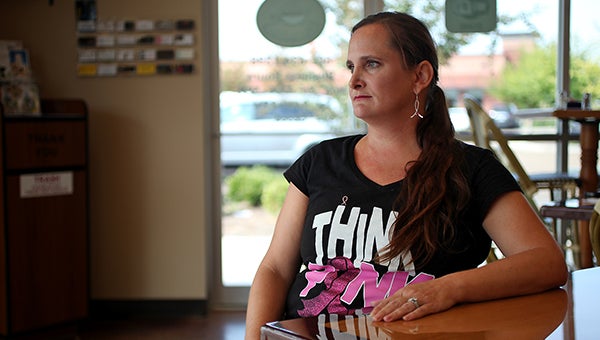Breast reconstruction a long, challenging road for survivors
Published 12:00 am Sunday, October 11, 2015

- SURVIVOR: Breast cancer survivor Lucy Spangler underwent a bilateral mastectomy in 2006. Following six months of chemotherapy she had reconstructive breast surgery. (Justin Sellers/The Vicksburg Post)
Breast removal is no different from any other form of amputation. Part of a woman’s body is being removed.
“It’s almost like going through a death, you do miss them,” Lucy Spangler said after having both of her breasts removed because of a cancer diagnosis.
Spangler was diagnosed with Ductal Carcinoma in 2006, and following her bilateral mastectomy and six months of chemotherapy, she began the process of having breast reconstructive surgery performed.
Even though Spangler said she had always wanted to have a breast reduction, being diagnosed with breast cancer and having to have a double mastectomy was not the method she would have chosen to reduce her cup size.
Spangler said friends and doctors tried to persuade her to have only one breast removed because recovery is compounded when a woman undergoes a double mastectomy, but Spangler said her mind was made up.
She wanted to reduce her chances of the breast cancer returning.
There are several types of breast reconstruction options a woman will be faced with choosing, and because Spangler had to have all of her breast tissue remove, cadaver skin and mesh were used in the latissimus dorsi flap procedure, she had performed.
This procedure tunnels muscle, fat, skin and blood vessels from your upper back, under the front of the chest.
Spangler had undergone two previous surgeries earlier in the year, a cesarean section and a gall bladder removal, so some of the other methods of reconstruction were eliminated, she said.
Once her breasts were removed, she said expanders were inserted under the skin at her chest area to make way for breast implants.
Spangler likened the expanders to balloons, which would slowly be filled over time with a saline solution.
“They (the expanders) have to push and expand your skin,” she said.
Drainage tubes were also inserted during Spangler’s surgery.
Unfortunately, this was one of the more painful aspects of the reconstructive process, she said.
“We would have to drain them and that was the worst.”
Before being able to proceed with her expansion process, Spangler had a six-month waiting period because she had to complete chemotherapy treatments.
“I had to take chemotherapy because I was so young (when I was diagnosed),” Spangler said.
Once the treatments ended, she began having the saline injected into her expanders, she said.
“They would poke a needle in (through her skin and into the expanders) and fill them up with saline.”
Spangler equated the discomfort following this procedure to breast milk coming in following the birth of a child.
The number of times a woman will have to keep going back to have saline injected will depend on the breast size she desires.
For Spangler, it took about three months, she said.
“I had to go back about four or five times. The doctor wanted me to be a D, and I wanted a B, so we compromised on a small C.”
After the expanders had done their job, Spangler said her drainage tubes were removed and breast implants were inserted.
Following the healing from the implants, a woman will also have the opportunity to choose to have nipples constructed and or tattooing performed.
“I chose not to get nipples. I asked my husband, and he said he was OK with my decision,” Spangler said.
“I didn’t want them because they would stick out all the time,” she added.
However, Spangler said she did choose to tattoo the nipple areas of her breasts.
“The inking process was very painful.”
Nine years, later, Spangler says everything is good.
“I can say cancer has taught me to fight. Not just for my life, but for my children.”
Spangler is the mother of two daughters and knows that they now have an 85 percent chance of getting breast cancer, but with today’s technology and the advances made in plastic surgery, women now have options for replacing something lost when faced with breast removal.
“My breasts make me feel sexy, but if they are going to kill me, I can be sexy without them,” Spangler said.






